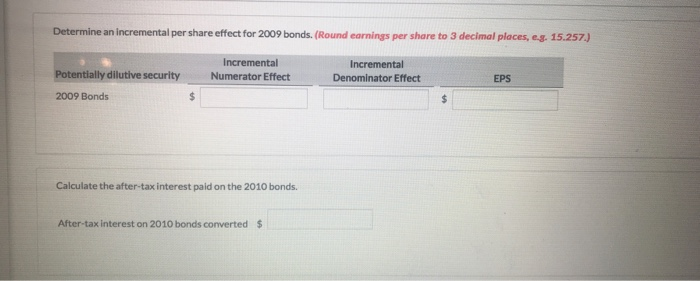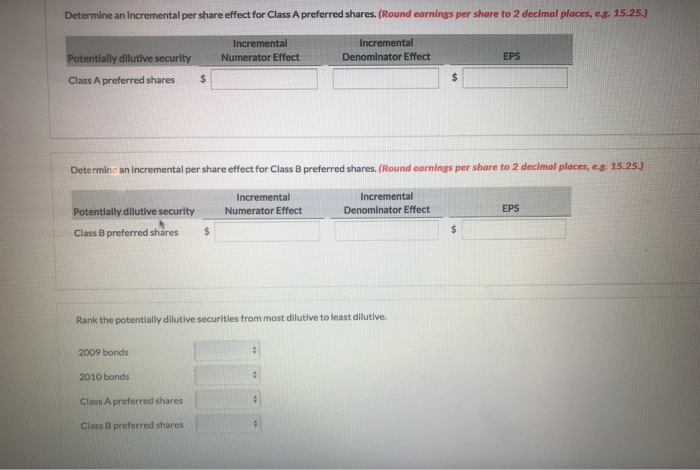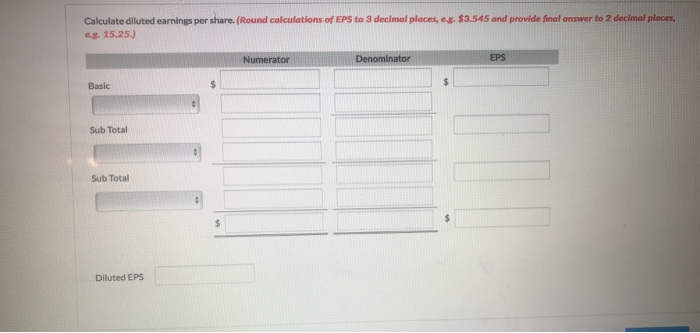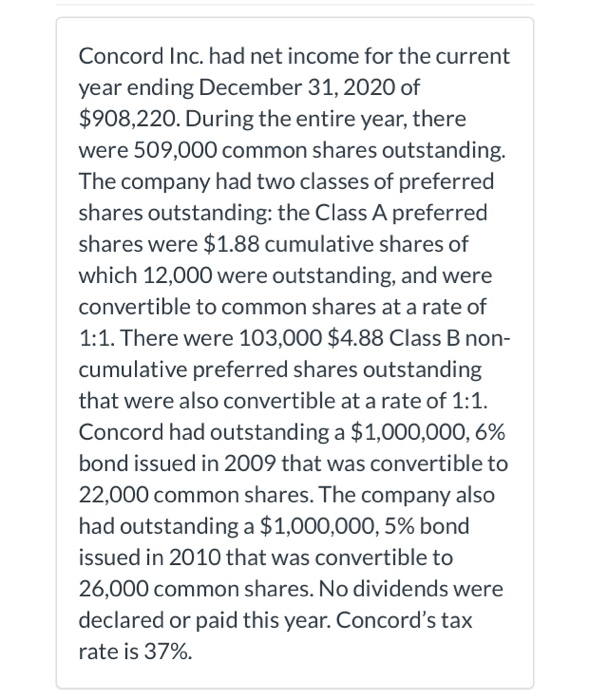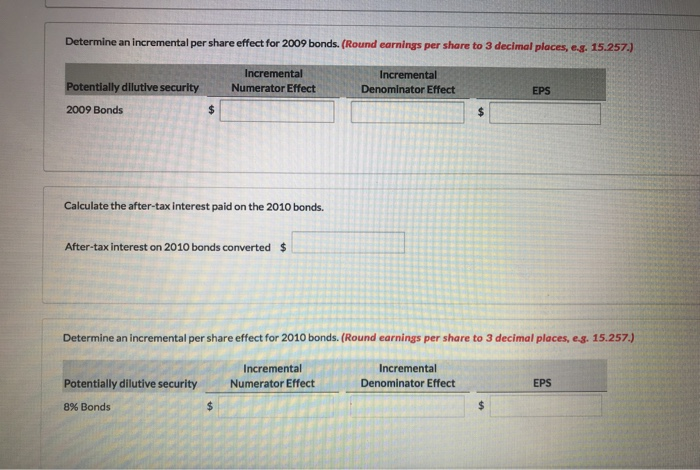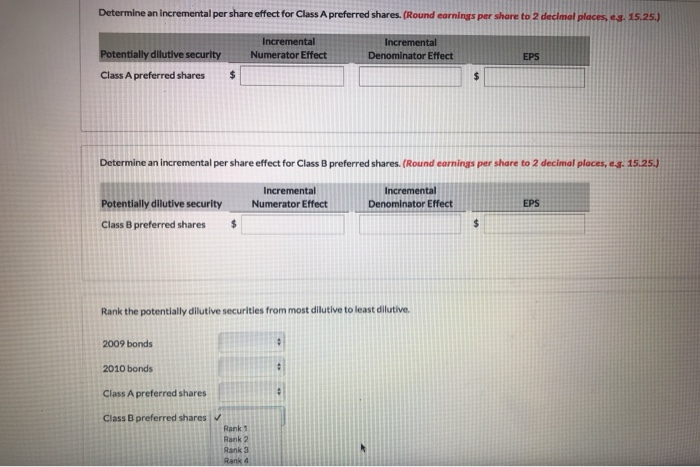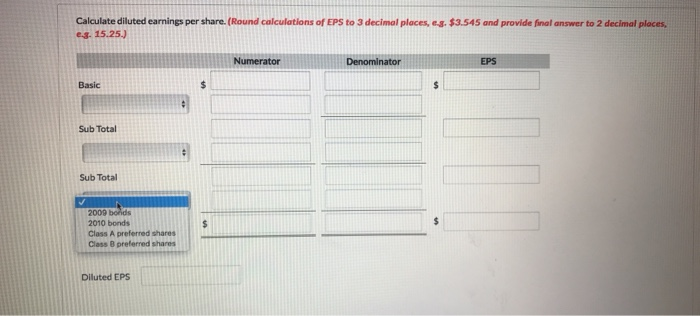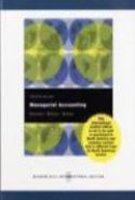Concord Inc. had net income for the current year ending December 31, 2020 of $908,220. During the entire year, there were 509.000 common shares outstanding. The company had two classes of preferred shares outstanding: the Class A preferred shares were $1.88 cumulative shares of which 12,000 were outstanding, and were convertible to common shares at a rate of 1:1. There were 103,000 $4.88 Class B non-cumulative preferred shares outstanding that were also convertible at a rate of 1.1. Concord had outstanding a $1,000,000,6% bond issued in 2009 that was convertible to 22.000 common shares. The company also had outstanding a $1,000,000, 5% bond issued in 2010 that was convertible to 26,000 common shares. No dividends were declared or pald this year. Concord's tax rate is 37%. Determine an incremental per share effect for 2009 bonds. (Round earnings per share to 3 decimal places, s. 15.257.) Potentially dilutive security Incremental Numerator Effect Incremental Denominator Effect EPS 2009 Bonds Calculate the after-tax interest paid on the 2010 bonds. After-tax interest on 2010 bonds converted $ Determine an incremental per share effect for Class A preferred shares. (Round earnings per share to 2 decimal places... 15.25.) Incremental Numerator Effect Incremental Denominator Effect Potentially dilutive security EPS Class A preferred shares $ Determine an incremental per share effect for Class B preferred shares. (Round earnings per share to 2 decimal places, eg. 15.25.) Incremental Numerator Effect Incremental Denominator Effect EPS Potentially dilutive security Class B preferred shares Rank the potentially dilutive securities from most dilutive to least dilutive. 2009 bonds 2010 bonds Class A preferred shares Class B preferred shares Calculate diluted earnings per share. (Round calculations of EPS to 3 decimal places, es $3.545 and provide final answer to 2 decimal places, 15.25.) Numerator Denominator Basic Sub Total Sub Total Diluted EPS Concord Inc. had net income for the current year ending December 31, 2020 of $908,220. During the entire year, there were 509,000 common shares outstanding. The company had two classes of preferred shares outstanding: the Class A preferred shares were $1.88 cumulative shares of which 12,000 were outstanding, and were convertible to common shares at a rate of 1:1. There were 103,000 $4.88 Class B non- cumulative preferred shares outstanding that were also convertible at a rate of 1:1. Concord had outstanding a $1,000,000, 6% bond issued in 2009 that was convertible to 22,000 common shares. The company also had outstanding a $1,000,000, 5% bond issued in 2010 that was convertible to 26,000 common shares. No dividends were declared or paid this year. Concord's tax rate is 37%. Determine an incremental per share effect for 2009 bonds. (Round earnings per share to 3 decimal places, s. 15.257.) Incremental Numerator Effect Incremental Denominator Effect EPS Potentially dilutive security 2009 Bonds Calculate the after-tax interest paid on the 2010 bonds. After-tax interest on 2010 bonds converted $ Determine an incremental per share effect for 2010 bonds. (Round earnings per share to 3 decimal places, e.g. 15.257.) Incremental Numerator Effect Incremental Denominator Effect Potentially dilutive security EPS 8% Bonds Determine an incremental per share effect for Class A preferred shares. (Round earnings per Share to 2 decimal places 15.25.) Incremental Numerator Effect Incremental Denominator Effect EPS Potentially dilutive security Class A preferred shares Determine an incremental per share effect for Class B preferred shares. (Round earnings per share to 2 decimal places, e..15.25.) Incremental Numerator Effect Incremental Denominator Effect Potentially dilutive security Class B preferred shares Rank the potentially dilutive securities from most dilutive to least dilutive 2009 bonds 2010 bonds Class A preferred shares Class B preferred shares Rank 1 Rank 2 Rank 3 Ranka Calculate diluted earnings per share. (Round calculations of EPS to 3 decimal places, es $3.545 and provide final answer to 2 decimal places, 15.25.) Numerator Denominator EPS Basic Sub Total Sub Total 2009 bonds 2010 bonds Class A preferred shares Class preferred shares Diluted EPS

